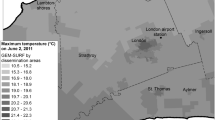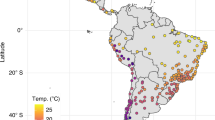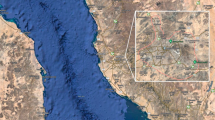Abstract
Excess mortality has been noted during high ambient temperature episodes. During such episodes, individuals are not likely to be uniformly exposed to temperatures within cities. Exposure of individuals to high temperatures is likely to fluctuate with the micro-urban variation of outdoor temperatures (heat island effect) and with factors linked to building properties. In this paper, a GIS-based regression mapping approach is proposed to model urban spatial patterns of indoor temperatures in time, for all residential buildings of an urban area. In July 2005, the hourly indoor temperature was measured with data loggers for 31 consecutive days, concurrently in 75 dwellings in Montreal. The general estimating equation model (GEE) developed to predict indoor temperatures integrates temporal variability of outdoor temperatures (and their 24 h moving average), with geo-referenced determinants available for the entire city, such as surface temperatures at each site (from a satellite image) and building characteristics (from the Montreal Property Assessment database). The proportion of the variability of the indoor temperatures explained increases from 20%, using only outdoor temperatures, to 54% with the full model. Using this model, high-resolution maps of indoor temperatures can be provided across an entire urban area. The model developed adds a temporal dimension to similar regression mapping approaches used to estimate exposure for population health studies, based on spatial predictors, and can thus be used to predict exposure to indoor temperatures under various outdoor temperature scenarios. It is thus concluded that such a model might be used as a means of mapping indoor temperatures either to inform urban planning and housing strategies to mitigate the effects of climate change, to orient public health interventions, or as a basis for assessing exposure as part of epidemiological studies.
This is a preview of subscription content, access via your institution
Access options
Subscribe to this journal
Receive 6 print issues and online access
$259.00 per year
only $43.17 per issue
Buy this article
- Purchase on Springer Link
- Instant access to full article PDF
Prices may be subject to local taxes which are calculated during checkout

Similar content being viewed by others
References
Aniello C., Morgan K., Busbey A., and Newland L. Mapping micro-urban heat islands using landsat TM and a GIS. Computers and Geosciences 1995: 21: 965–969.
Basu R., and Samet J.M. Relation between elevated ambient temperature and mortality: a review of the epidemiologic evidence. Epidemiol Rev 2002: 24: 190–202.
Blum L.N., Bresolin L.B., and Williams M.A. Heat-related illness during extreme weather emergencies. JAMA 1998: 279: 1514.
Briggs D.J., de Hoogh C., Gulliver J., Wills J., Elliott P., Kingham S., et al. A regression-based method for mapping traffic-related air pollution: application and testing in four contrasting urban environments. Sci Total Environ 2000: 253: 151–167.
De Dear R., and Brager G.S. The adaptative model of thermal comfort and energy conservation in the built environment. Int J Biometeorol 2001: 45: 100–108.
Fouillet A., Rey G., Laurent F., Pavillon G., Bellec S., Guihenneuc-Jouyaux C., et al. Excess mortality related to the August 2003 heat wave in France. Int Arch Occup Environ Health 2006: 80: 16–24.
Kanda M. Progress in the scale modeling of urban climate: Review. Theor Appl Climatol 2005: 84: 23–33.
Koppe C., Kovats R.S., Jendritzky G., and Menne B. Heat-waves: impacts and responses. In: Health and Global Environmental Change Series, no. 2 WHO Regional Office for Europe (ed.), Copenhagen, 2004, 123p.
Liang K.Y., and Zeger S.L. Longitudinal data analysis using generalized linear models. Biometrika 1986: 73: 13–22.
Lo C.P., Quattrochi D.A., and Luvall J.C. Application of high-resolution thermal infrared remote sensing and GIS to assess the urban heat island effect. Int J Remote Sensing 1997: 18: 287–304.
Ratti C., Di Sabatino S., and Britter R. Urban texture analysis with image processing techniques: winds and dispersion. Theor Appl Climatol 2006: 84: 77–90.
Semenza J.C., Rubin C.H., Falter K.H., Selanikio J.D., Flanders W.D., Howe H.L., et al. Heat-related deaths during the July 1995 heat wave in Chicago. N Engl J Med 1996: 335: 84–90.
Smoyer K.E. Putting risk in its place: methodological considerations for investigating extreme event health risk. Soc Sci Med 1998: 47: 1809–1824.
Taha H. Urban climates and heat islands: albedo, evapotranspiration and anthropogenic heat. Energy and Buildings 1997: 25: 99–103.
Wilhelmi O.V., Purvis K.L., and Harriss R.C. Designing a geospatial information infrastructure for mitigation of heat wave hazards in urban areas. Nat Hazards Rev 2004: 5: 147–158.
Wright A.J., Young A.N., and Natarajan S. Dwelling temperatures and comfort during the 2003 heat wave. Building Service Engineers 2005: 26: 285–300.
Acknowledgements
This project was supported by funding from the Natural Resources Canada Climate Change Action Fund (#A1101). We thank Sophie Goudreau, Geneviève Lachance, Julie Dufresne and her assistants for their technical work. We also thank Frédéric Guay, who processed the thermal image and all the participants who allowed temperatures to be measured in their homes.
Author information
Authors and Affiliations
Corresponding author
Rights and permissions
About this article
Cite this article
Smargiassi, A., Fournier, M., Griot, C. et al. Prediction of the indoor temperatures of an urban area with an in-time regression mapping approach. J Expo Sci Environ Epidemiol 18, 282–288 (2008). https://doi.org/10.1038/sj.jes.7500588
Received:
Accepted:
Published:
Issue Date:
DOI: https://doi.org/10.1038/sj.jes.7500588
Keywords
This article is cited by
-
Detection and quantification of seasonal human heat and cold stress frequencies in representative existing and future urban canyons: the case of Ankara
Theoretical and Applied Climatology (2023)
-
Indoor heat exposure in Baltimore: does outdoor temperature matter?
International Journal of Biometeorology (2021)
-
Relationship among environmental quality variables, housing variables, and residential needs: a secondary analysis of the relationship among indoor, outdoor, and personal air (RIOPA) concentrations database
International Journal of Biometeorology (2017)
-
Effects of ventilation behaviour on indoor heat load based on test reference years
International Journal of Biometeorology (2016)
-
Heterogeneity in individually experienced temperatures (IETs) within an urban neighborhood: insights from a new approach to measuring heat exposure
International Journal of Biometeorology (2015)



